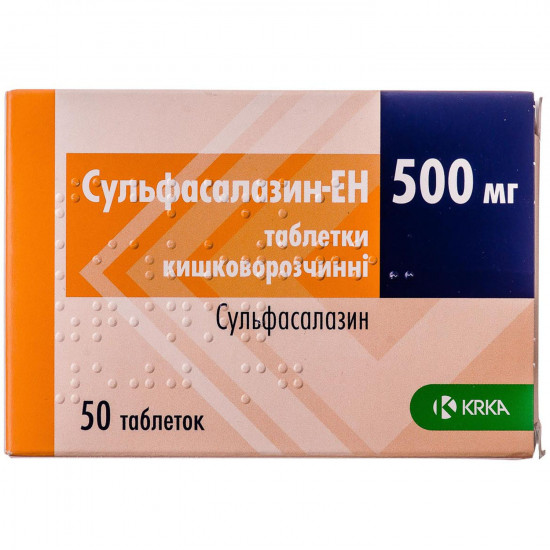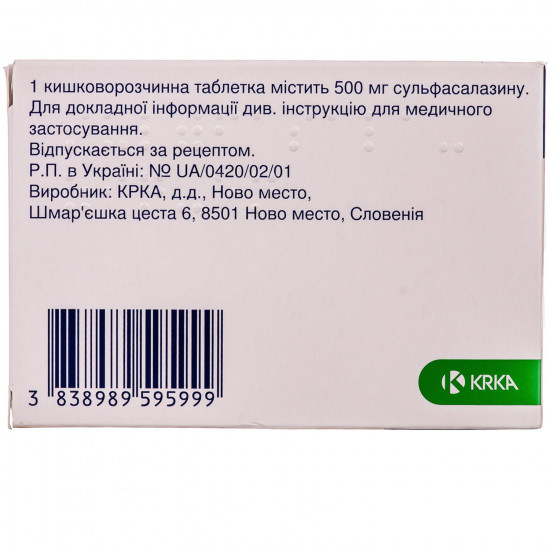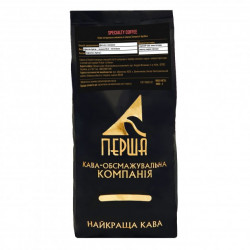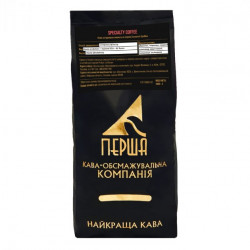



- Stock: In Stock
- Model: 184585
0% Customers recommend this product
-
5 Awesome0%
-
4 Great0%
-
3 Average0%
-
2 Bad0%
-
1 Poor0%
Reviews Over Sulfasalazinum HAN of the tab. of p/o of 500 mg No. 50
- (0)
Total Reviews (0)
click here write review to add review for this product.
Report this review.
Description
Pharmacological properties
Pharmacodynamics. Sulfasalazinum is anti-inflammatory drug. has immunosuppressive effect, especially in connective tissue, an intestinal wall and serous liquid where its concentration the highest. thanks to indestinal flora Salazosulfapyridinum breaks up to sulphapyridine and 5-aminosalicylic acid. sulphapyridine suppresses proliferation of cells killers and transformation of lymphocytes.
Sulfasalazinum HAN — in the form of kishechnorastvorimy tablets, collects in connective tissue of intestines with release of the 5-aminosalicylic acid possessing anti-inflammatory action and sulphapyridine which has antimicrobial effect concerning diplococcuses, streptococci, gonokokk, colibacillus.
Drug shows immunosuppressive action, especially in connective tissue, an intestinal wall and serous liquid where its concentration the highest. Sulphapyridine reduces system inflammation and has antibacterial effect, interferes with action of natural cellular killers and transformation of leukocytes.
Anti-inflammatory effect of 5-aminosalicylic acid (mesalazin) is most of all shown byat treatment of inflammatory bowel diseases. Generally 5-aminosalicylic acid locally inhibits COG and a lipoxygenase in an intestinal wall and thus prevents formation of prostaglandins, leukotrienes and other mediators of inflammation. Thanks to low absorption reduces inflammation in a large intestine.
Pharmacokinetics. About 30% of the accepted dose of Sulfasalazinum are absorbed in a small intestine, and 70% are metabolized by colibacilli in a large intestine in sulphapyridine and 5-aminosalicylic acid. With max Sulfasalazinum and its metabolites in blood plasma enough considerably differs at different patients — at the low level of acetylation they much higher and are connected with frequent cases of emergence of side effects. With max Sulfasalazinum in blood plasma is reached in 3–12 h after reception of enterosoluble tablets and 12–24 h — after reception of tablets, coated. It contacts proteins of blood plasma and well gets into connective tissue. The main part of the absorbed amount of Sulfasalazinum returns with bile to intestines; the insignificant quantity is distinguished in not changed view with urine. T ½ Sulfasalazinum — 5–10 h
Is metabolized byin a liver (by acetylation, hydroxylation and conjugation with glucuronic acid), excreted by kidneys. T ½ — 6–14 h, depending on acetylation speed. Only 30% of 5-aminosalicylic acid are absorbed, acetylated in a liver and 70% are removed with urine — in not changed view with a stake.
Indication
Sulfasalazinum: bad attack or exacerbation of Crohn's disease, ulcer colitis; for support of the period of remission for ulcer colitis.
Sulfasalazinum HAN: inflammatory bowel diseases (for example, Crohn's disease, nonspecific ulcer colitis);
a pseudorheumatism at adults, juvenile rheumatoid polyarthritis (as a part of auxiliary therapy).
Use
Dose should be selected individually, considering disease severity and a possibility of development of side effects.
Patients have to take a pill at meal time. It is necessary to swallow of tablets whole, washing down with a glass of liquid.
byIf in due time did not accept the next dose of drug, it is necessary to accept it as soon as possible. If already time of reception of the following dose comes, it is necessary to continue the recommended schedule of treatment (without doubling of a dose).
Sulfasalazinum HAN
Inflammatory bowel diseases
Treatment of acute condition:
Initial dose for adults makes 2–4 tablets (1–2 g) a day. It is necessary to divide a daily dose not less than into 3 receptions. The dose is gradually raised to 3–8 g
to the Patients who were earlier not accepting Sulfasalazinum HAN it is recommended to raise a dose gradually for 9 days.
to Children 6 years are aged more senior thanit is recommended to apply 40–150 mg/kg of body weight a day. It is necessary to divide a daily dose not less than into 3 receptions.
Maintenance of the period of remission
Recommended maintenance dose for adults makes 4–6 tablets (2–3 g) a day. It is necessary to divide a daily dose not less than into 3 receptions.
At children 6 years are aged more senior thanapply 20–75 mg/kg of body weight a day. It is necessary to divide a daily dose not less than into 3 receptions.
Pseudorheumatism and juvenile polyarthritises
Recommended dose for adults makes 2 g a day. Patients should begin treatment with 1 tablet (500 mg) of Sulfasalazinum a day. It is necessary to raise Sulfasalazinum dose gradually, with week intervals, to achievement of a dose of 2 g/days (the daily dose is required to be divided into 2–4 receptions). At some patients the significant clinical effect can be reached after 12 weeks of treatment. If clinical effect after 12 weeks of use insufficient, the daily dose is raised to 3 g
in case of use of a dose higher than 2 g/days it can be necessary to control a condition of the patient constantly.
to Children 6 years a dose of medicament are aged more senior thandoctor at the rate of 30–75 mg of a sulfazalazin on 1 kg of body weight a day in 2–3 receptions defines. Children transfer medicament better if the initial dose is 3-4 times lower recommended and gradually raises within a month before achievement of a maintenance dose. To children appoint no more than 4 tablets (2 g) a day.
Contraindication
Hypersensitivity to a sulfazalazin, streptocides and salicylates, a porphyria, a granulocytopenia. children's age. for Sulfasalazinum-en — age up to 6 years.
Side effectsMajority of side effects of Sulfasalazinum insignificant are also connected by
mainly with degree of concentration of sulphapyridine in blood plasma, especially at persons with its slowed-down removal (the slowed-down acetylation). side effects develop mainly at patients with a pseudorheumatism.
General
Hyperthermia, coloring in yellow-orange color of urine, skin or soft contact lenses.
from a cardiovascular system
Pericarditis.
from a GIT
it is frequent: nausea, vomiting, diarrhea and loss of appetite.
it is rare: hepatitis, pancreatitis, stomatitis and parotitis.
Hematologic disturbances
it is frequent: macrocytosis (9%), leukopenia (3.7%) and neutropenia (2%).
it is rare: megaloblastichesky anemia, hemolytic anemia, methemoglobinemia, anemia, agranulocytosis, thrombocytopenia, aplastic anemia and prothrombinopenia.
from central nervous system
It is very frequent: headache (30%).
it is rare: peripheral neuropathy, dizziness, sonitus, ataxy, insomnia, hallucinations, convulsions and aseptic meningitis; encephalopathy — for Sulfasalazinum HAN .
Mental disturbances: a depression — for Sulfasalazinum HAN .
from sense bodys
Disturbance of flavoring feelings, sense of smell, a ring in ears.
from an urinogenital system
Proteinuria, a hamaturia, a crystalluria, a nephrotic syndrome, an oligospermatism and male infertility having reversible character. At patients with a porphyria the aggravation of attacks is possible.
Allergic reactions
It is very rare: rash on skin, urticaria, an erythema, an itching, exfoliative dermatitis, photosensitive reactions, a multiformny dieback, a toxic epidermal necrolysis, Stephens's syndrome — Johnson, Shegren's syndrome, a system lupus erythematosus, a serum disease, fever, a lymphadenopathy, periorbital hypostasis, a conjunctival or scleral nodular polyarteritis and an eosinophilia.
from a respiratory system
it is rare: short wind, cough, infiltrates in lungs and a fibrous alveolitis.
from a musculoskeletal system
it is rare: arthralgia.
Change of laboratory indicators
throughout treatment by Sulfasalazinum levels of activity of amylase, bilirubin, alkaline phosphatase and transaminase of a liver can increase.
toSpecial instructions
byrecommends performing the general blood test (in an initiation of treatment — 1–2 times a month, then — each 3–6 months) and the analysis of urine before an initiation of treatment and also periodically in the course of treatment at patients with a renal failure. use needs to be stopped immediately in case of suspicion or laboratory confirmation of serious hematologic violations.
Is required to carry outcontrol of function of a liver monthly for the first 3 months of use of drug. To patients with abnormal liver functions Sulfasalazinum is appointed with care.
Control of a condition of function of kidneys needs to be carried out in an initiation of treatment and throughout therapy by drug. To patients with insufficiency glucose-6-fosfatdegidrogenazy medicament is used with care as Sulfasalazinum can cause hemolytic anemia.
toduring treatment recommends plentiful drink.
Change of laboratory indicators of blood (macrocytosis, a pancytopenia) owing to insufficiency of folic acid can be normalized by intake of folic or folinovy acids.
toSpecial observation during treatment by Sulfasalazinum is necessary for patients with a renal or liver failure, OH and an allergy (the cross hypersensitivity to the furosemide, thiazide diuretics derivative of sulphonylurea, karbonangidraza inhibitors is possible). In case of appearance of an allergy or other side effects the use of Sulfasalazinum is required to be stopped immediately. At not severe forms of an allergy to Sulfasalazinum performing desensitization is possible.
Use during pregnancy and feeding by a breast. Negative impact of Sulfasalazinum completely is not excluded therefore medicament is used at pregnant women only on strict indications. For the period of treatment the feeding by a breast needs to be stopped.
Children. Sulfasalazinum HAN is applied at children aged 6 years are more senior.
Ability to influence speed of response at control of vehicles or work with other mechanisms. During treatment it is necessary to refrain from management transport sredstvamy and works with other mechanisms.
Interaction
Sulfasalazinum reduces absorption of folic acid and digoxin. the use of enough liquid and an exception of acylation of urine (for example, owing to the accompanying intake of hexamethylenetetramine) can reduce manifestations of a crystalluria and formation of stones.
Streptocides have similarity to some oral gipoglikemiziruyushchy agents. Therefore at some patients who accept streptocides the hypoglycemia can be observed. Patients who in parallel apply Sulfasalazinum and gipoglikemiziruyushchy means have to be under observation of the doctor.
At simultaneous use with anticoagulants and gipoglikemiziruyushchy means — sulphonylurea derivatives — is strengthened by their action. Due to the inhibition the oppression of function of marrow and a leukopenia can arise thiopurinemethyltransferase enzyme Sulfasalazinum at simultaneous use of Sulfasalazinum and thiopurine-6-Mercaptopurinum or azathiopurine.
Use of Sulfasalazinum and a methotrexate for patients with a pseudorheumatism does not influence medicament pharmacokinetics. However it was reported about increase in frequency of side effects from a GIT, in particular nausea. Antibiotics can reduce efficiency of Sulfasalazinum and Sulfasalazinum HAN.
Overdose
Patients with a renal failure have higher risk of heavy overdose. high doses of Sulfasalazinum serve as the reason of appearance of nausea, vomiting and abdominal pain. at overdose the anury, a crystalluria, a hamaturia and symptoms of toxic damage of central nervous system (spasm) are possible. the toxicity is proportional to concentration of sulphapyridine in blood.
toneeds careful observation of a condition of the patient as in certain cases there can be a methemoglobinemia or a sulfagemoglobinemiya that demands the corresponding treatment.
toAt emergence of symptoms of overdose needs gastric lavage, to clean intestines, to carry out urine alkalization, an artificial diuresis. In case of an anury and/or a renal failure consumption of liquid and electrolytes should be limited. The efficiency of measures is estimated on the level of concentration of sulphapyridine in blood plasma. Specific antidote is absent.
Storage conditions
At a temperature up to 25 °C.
Specifications
| Characteristics | |
| Active ingredients | Sulfasalazinum |
| Amount of active ingredient | 500 mg |
| Applicant | KRK |
| Code of automatic telephone exchange | A07EC01 Sulfasalazinum |
| Interaction with food | In time |
| Light sensitivity | Not sensitive |
| Market status | Generic-generic |
| Origin | Chemical |
| Prescription status | According to the prescription |
| Primary packing | blister |
| Producer | KRK D.D. |
| Quantity in packing | 50 tablets (5 blisters on 10 pieces) |
| Release form | tablets for internal use |
| Route of administration | Oral |
| Sign | Import |
| Storage temperature | from 5 °C to 25 °C |
| Trade name | Sulfasalazinum |




















